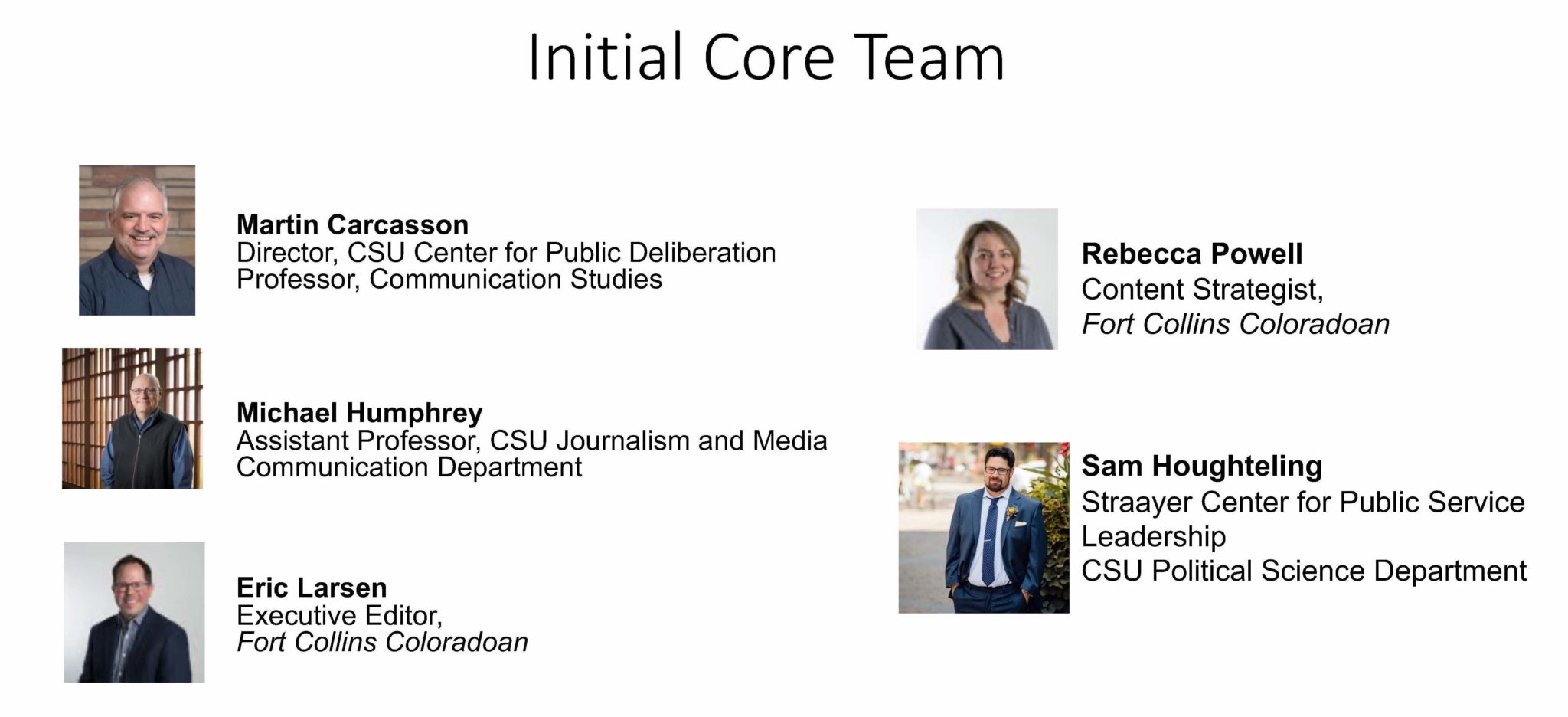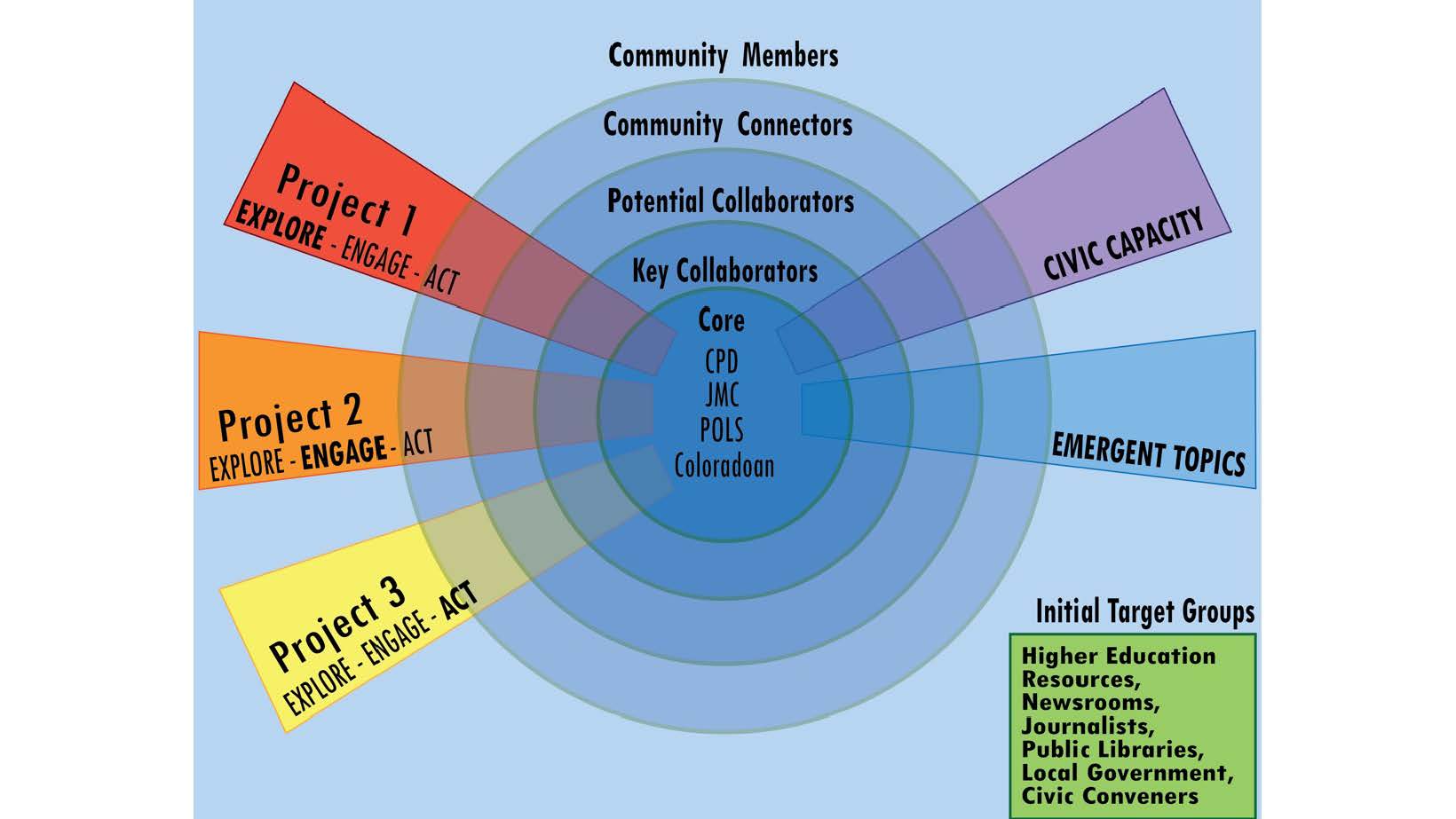A group of Colorado State University faculty has joined forces with the Coloradoan newspaper on a project to improve Northern Colorado’s information ecosystem and address shared community problems more effectively.
The Northern Colorado Deliberative Journalism Project was launched this fall when the American Press Institute awarded a $10,000 grant to the Coloradoan and CSU’s Center for Public Deliberation to support initial discussions. On Oct. 20, organizers met with potential collaborators, including public libraries staff, municipal staff, CSU faculty, KUNC, the North Forty News and the Estes Park Trail-Gazette. The group will host a public meeting on Nov. 17 via Zoom from 6 to 8 p.m.
Leaders of the initiative point to several reasons for improving how local communities collaboratively discuss and address regional issues:
- The importance of local journalism to the quality of democracy
- Numerous challenges to the traditional journalism model
- Challenges and opportunities of social media
- Growing polarization and misinformation
- Growing distrust in our institutions
- Explosion in the amount of data available
- Developing innovations in local journalism

CSU team members
CPD Director and Professor of Communication Studies Martin Carcasson, Assistant Professor Michael Humphrey of the Department of Journalism and Media Communication and Straayer Center for Public Service Leadership Program Manager Sam Houghteling are the three CSU faculty members on the initial core team of the project. Carcasson said that he began to think about the need for such an effort when the Coloradoan discontinued its print opinion section and community editorial board in 2019.
“We lost an important resource for the community on nuanced issues,” he said. “With this initiative, we want to address misinformation, ensure we have a broad range of voices and improve the way we talk to each other about solving shared community challenges.”
The group settled on the term “deliberative journalism” for the project after some discussions.
“Deliberative journalism is focused on helping a community authentically engage difficult issues,” Carcasson explained. “It helps spark the kind of robust conversations we need to have and avoids some of the pitfalls that have undermined political discussions.”

Initial key components
There are three initial components for the project:
- Improve coverage of local issues through collaboration and equipping students to help support the efforts (such as deploying them to cover issues in small towns without a media outlet).
- Longer term projects in which CSU faculty and students will work with local newsrooms and community organizations to complete deeper dives on regional problems like housing, transportation and water.
- Building civic capacity for supporting ongoing information management and conversations that are critical to local communities.
“We have faculty at CSU and other local institutions that are not only researching local issues but also topics like how to address misinformation, engage difficult issues across perspectives, avoid polarization, communicate science effectively and support collaborative efforts,” Carcasson said. “We want to facilitate mutually beneficial learning exchanges between them and journalists, government staff and community leaders so we can really improve the information we have available and how the community engages issues.”
Humphrey said that the effort is expected to equip journalism students with the skills taught in the CPD, which trains students how to bring often disparate groups together for public policy discussions that lead to solutions instead of conflict.
“This is journalism as facilitation and deliberation,” Humphrey said. “A lot of people in our department are looking for ways to take what we know how to do and apply it in a way that focuses on the health of the community. This could expand reporters’ toolkits. The really exciting prospect is that students walk out with a tool that most communities have never seen used by journalists before.”
Shifting the media’s focus
Coloradoan Executive Editor Eric Larsen, who along with Coloradoan Content Strategist Rebecca Powell round out the core team, said that one goal of the project is to encourage regional journalists to focus less on conflict and more on constructive dialogue.
“We can be the messenger for how the smart minds in a community are going to tackle problems and come to solutions,” he said. “To me, it’s having that solutions-based mindset in our reporting. Not just the old-fashioned ‘Hey, look over here, these people are fighting, isn’t that interesting?’ but really being part of that long, hard process that leads to community change.”
Humphrey added that the project may lead others to adopt the same approach.
“Once other communities see how it works, they may say, ‘We want that, we need you to bring it here,’” he said. “Then we’d have a model to share with a much broader community.”
It’s a mutually beneficial project for all partners involved, Larsen said.
“To have a focused conversation around journalism using the CPD model is something we couldn’t do on our own – news outlets aren’t very good at taking the long view,” he explained. “Maybe someday all our competitors and compatriots are sitting at the table and working together toward a more robust information ecosystem in Northern Colorado that’s a little more trusted, a little easier to navigate, and serving the highest purpose it can.”
More information about the project’s six initial tasks is available online, as is a survey and RSVP form for the Nov. 17 event.